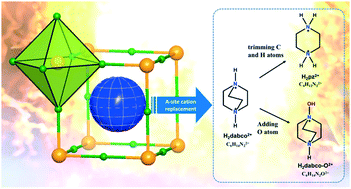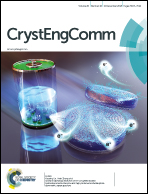Optimizing the oxygen balance by changing the A-site cations in molecular perovskite high-energetic materials†
Abstract
We presented two new members of molecular perovskite high-energetic materials, (H2pz)[Na(ClO4)3] (PAP-1) and (H2dabco-O)[K(ClO4)3] (DAP-O2), in which H2pz2+ (piperazine-1,4-diium) and H2dabco-O2+ (1-hydroxy-1,4-diazabicyclo[2.2.2]octane-1,4-diium) act as A-site fuel cations, respectively. Compared with their H2dabco2+ analogues, (H2dabco)[M(ClO4)3] (H2dabco2+ = 1,4-diazabicyclo[2.2.2]octane-1,4-diium, M = Na+ for DAP-1 and K+ for DAP-2, respectively), PAP-1 and DAP-O2 exhibit optimized oxygen balance by employing two strategies to change the A-site cations, i.e., “trimming the C and H atoms” of H2dabco2+ by using H2pz2+ to form PAP-1 and adding an O atom into H2dabco2+ by using H2dabco-O2+ to form DAP-O2, respectively. As suggested by DFT calculations and the K–J equation, the smaller H2pz2+ cation in PAP-1 gives a significantly-optimized oxygen balance from −22.0% to −3.9% and an increased crystal density from 2.02 to 2.07 g cm−3, resulting in a better detonation performance for PAP-1. Meanwhile the larger H2dabco-O2+ cation gives a slightly-optimized oxygen balance from −21.3% to −17.1% but a decreased crystal density from 2.04 to 1.98 g cm−3, leading to a decreased detonation performance from DAP-2 to DAP-O2. This study demonstrated how to rationally choose the A-site cations in a perovskite structure for modulating the properties of molecular perovskite high-energetic materials, providing important clues for designing more advanced energetic materials for practical use.

- This article is part of the themed collection: CrystEngComm 20th volume collection


 Please wait while we load your content...
Please wait while we load your content...